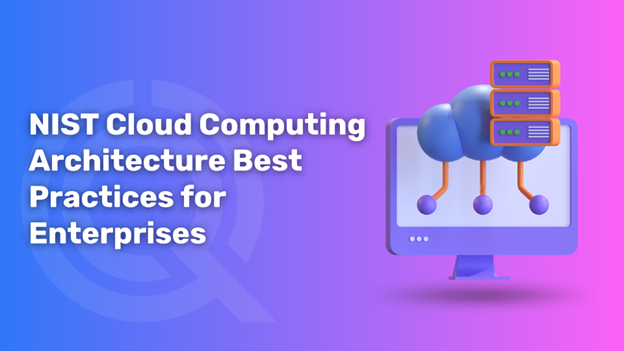What is Cloud Computing Architecture?
Cloud computing architecture is the plan that specifies how to create, integrate, and maintain cloud services and resources. At its heart, the NIST Cloud Computing Architecture consists of:
- Front-end: “Front-end” denotes the dashboards, online portals, or client apps that consumers use to interact with the interfaces.
- Back-end: Applications, databases, and servers operating silently to provide services.
- Middleware: Middleware is software that helps back-end and front-end elements control data and communication.
- Cloud services: Offered as cloud services are software as a service (SaaS), platform as a service (PaaS), and infrastructure as a service (IaaS).
- Storage systems: Storage systems are data repositories that are able to expand dynamically to contain company data.
Businesses provide reliable services, support for mission-critical workloads, and continuous operations clear of disruption via this infrastructure, as outlined by the NIST Cloud Computing Architecture.
Why Cloud Architecture Matters for Enterprises
Once merely an optional choice, cloud computing has grown to become the basis of digital transformation for companies right today. A well-designed cloud architecture determines whether a firm can preserve flexibility, appropriately scale, and protect critical assets. Often facing rising costs, compliance concerns, and security flaws, businesses rushing into the cloud without a sound architectural strategy find themselves struggling. Conversely, those who follow established best practices exhibit greater long-run value, agility, and resiliency.
This post examines the fundamental elements of cloud architecture, recommended procedures for businesses, and the great value of frameworks like the NIST architecture in directing implementation.
Best Practices for Cloud Architecture in Businesses
Designers need to carefully create a cloud architecture that balances security, cost, and performance. These best practices can help companies find that equilibrium.
1. Design for scalability and elasticity
The cloud’s major benefit is its capacity to dynamically scale assets. Organizations should use systems that automatically change capacity according to workload fluctuations. This eliminates wasted spending during calmer periods and avoids downtime during traffic surges.
2. Ensure cost efficiency
Unmonitored cloud use frequently results in “cloud sprawl,” whereby costs surge suddenly. Best practices call for setting spending policies, using cost optimization tools, and periodically reviewing resource use. Companies that include cost management in their design from the beginning prevent budget shocks.
3. Strengthen governance and compliance controls
Among the sectors with strict regulations in which companies operate are banking, government, and healthcare. Governance rules define who has access to what, how they save data, and how they meet regulatory needs in cloud architectures. Role-based access, audit reports, and continuous monitoring guarantee that legislative rules are never neglected.
4. Improve workload distribution
Not every program should run in the same cloud ecosystem. While some workloads benefit most from a public cloud, security or performance requirements call for private or hybrid configurations. One strategy for workload placement guarantees that organizations distribute applications in settings where they balance compliance, performance, and security.
Security Considerations in Cloud Architecture
No company can afford to neglect security. The dangers of ransomware, data breaches, and compliance failures are too great. The design of the cloud itself must include robust security.
Infrastructure security in cloud computing
Businesses have to safeguard servers, networks, and storage—the basis. Good methods include encrypting information both in transit and at rest, using micro-segmentation, patching often, and guaranteeing redundancy for disaster recovery.
Role of monitoring, IAM, and encryption
- Monitoring: Regular monitoring systems detect irregularities before they turn into breaches.
- Identity and Access Management (IAM): Stricter IAM policies help minimum-privilege ideas and prohibit unlawful access by means of Identity and Access Management (IAM).
- Encryption: Although caught in transit and at rest, encryption protects sensitive data.
Integrating a cloud security solution into the company’s plans
Advanced threat detection, compliance monitoring, and policy enforcement need companies to often depend on certain cloud security service providers. These solutions help internal security teams and allow cloud systems to resist ever more frequent cyberattacks.
NIST in Cloud Computing
Important in determining how companies view cloud adoption has been the National Institute of Standards and Technology (NIST).
What is the NIST model in cloud computing?
The NIST paradigm in cloud computing offers a precise definition of the fundamental features of the cloud, service models (IaaS, PaaS, and SaaS), and deployment models (public, private, hybrid, and community). For companies, it provides a uniform framework to make sense of the cloud landscape.
How does the NIST Cloud Computing Architecture benefit enterprises?
In cloud computing, the NIST architecture instructs how to organize, control, and provide services. Relying on this framework gives businesses a common language and standards that are consistent with industry best practices.
Why do enterprises use NIST in cloud computing frameworks?
NIST aids companies in grasping cloud computing paradigms. By offering benchmarks for the assessment of service providers, it guarantees compliance and enables secure, interoperable, and scalable systems. Many companies cut audits and risk management by matching NIST standards with their internal policies.
Actual-World Example: Enterprise Adoption
Imagine a multinational financial services firm moving its essential apps to the cloud. Designing a hybrid architecture instead of doing everything all at once:
- For scalability, developers keep consumer-facing applications in a public cloud.
- Sensitive transaction systems live in a private cloud to meet compliance demands.
- IAM, encryption, and multi-factor authentication help strengthen the security of cloud computing infrastructure.
- The company provides real-time monitoring and compliance reporting using a cloud security product.
- Last of all, the company compares its architecture to the NIST model in cloud computing to guarantee alignment and compliance.
This strategy enables the business to rapidly innovate while safeguarding sensitive information and satisfying legal requirements.
Conclusion: Building Resilient Cloud Architectures
Companies cannot view cloud adoption as another migration activity. It calls for a careful approach to architecture, one that balances scalability, cost, governance, and above all, security. Companies position themselves for long-term success by beginning with best practices.
Frameworks such as the NIST cloud computing architecture guarantee companies have a tried-and-true basis, thus guaranteeing their cloud systems are scalable, interoperable, and compliant with industry norms. Add to that the inclusion of cloud security service providers and strong infrastructure security, and companies now have the means to not only safeguard their assets but also unleash the full power of the cloud.
The way ahead is easy: design clever, safe, and standards-aligned cloud architectures, and companies will be ready to meet both present and future requirements.















